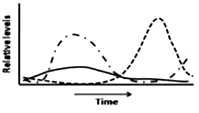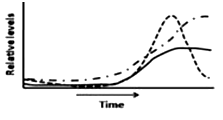 Multiple Choice Questions
Multiple Choice QuestionsA convenient and reasonably reliable indicator of the time of ovulation is usually a rise in the basal body temperature, possibly because progesterone is thermogenic. Of the four situation given below, which one is ideal for ensuring pregnancy after intercourse?




![]()
The afferent nerve fibres of a stretch reflex were electrically stimulated and the contraction of the muscle innervated by efferent fibres was recorded. The synaptic delay was calculated from the time points of the nerve stimulation and response of the muscle. Which one of the following time durations will be probable value for the observed synaptic delay?
0.05 msec
0.5 msec
0.5 sec
5.0 msec
When rods of retina kept in dark, were exposed to light, phototransduction occurred. Following are some explanations given by researcher regarding phototransduction:
A. Activation of transducin.
B. Inhibition of cGMP phosphodiesterase.
C. Closure of Na+ channels.
D. Hyperpolarization of rods.
Which one did NOT occur in phototransduction?
Only A
Only B
A and C
C and D
The difference in circulation between glomerular capillaries (GC) and true capillaries (TC) are described by a researcher in the following statements:
A. The hydrostatic pressure in GC is higher than that in TC.
B. The endothelial cells are fenestrated in GC but not in TC.
C. Both filtration and fluid movement into capillary takes place in TC but only filtration occurs in GC.
D. The plasma colloid osmotic pressures in both the ends of GC or TC are similar.
Which one of the following is NOT correct?
Only A
A and B
B and C
Only D
A visitor to a region of hot climate is more distressed by the heat than the regular resident. Within a few weeks, the visitor is more comfortable with the heat, and capacity for work is increased. Following are some of the explanations given by a researcher regarding acclimatization to heat.
A. Sweating begins at a lower body temperature.
B. Blood flow through skin is high for any body temperature.
C. There is rise in resting body temperature.
D. Vasoconstriction starts at a lower body temperature.
Which one of the following is NOT true?
Only A
A and B
Only C
C and D
D.
C and D
Among the given statements, statement C and D are incorrect statements.
After hemorrhage, a subject develops hypo-volemia and hypotension. Following are some of the statements regarding homeostatic measure taken by the body after hemorrhage.
A. Increased release of vasopressin.
B. Increased water retention and reduced plasma osmolality.
C. Increased rate of afferent discharge from low-pressure receptors of vascular system.
D. Decreased rate of afferent discharge from high pressure receptors of vascular system.
Which one of the following is NOT correct in this condition?
Only A
A and B
Only C
B and D
Which one of the following neurotransmitters are secreted by the pre-ganglionic neurons of the sympathetic nervous system?
Epinephrine
Acetylcholine
Dopamine
Norepinephrine
Which one of the following is NOT involved with the pacemaker potential of the heart?
"h"-channel
Transient calcium channel
Long-lasting calcium channel
"f"-channel
A diabetic patient developed metabolic acidosis resulting in deep and rapid breathing which is called-
Kussmaul breathing
Cheyne-Strokes respiratory pattern
Apneustic breathing
Periodic breathing
Match the following human diseases with their casual organisms.
| A. Sleeping sickness | i. Trypanosoma cruzi |
| B. Chagas disease | ii. Trypanosoma brucei |
| C. Elephantiasis | iii. Borrelia burgdorfei |
| D. Lyme disease | iv. Wuchereria bancrofti |
A - ii; B - iv; C - iii; D - i
A - i; B - ii; C - iv; D - iii
A - ii; B - i; C - iv; D - iii
A - ii; B - i; C - iv; D - iii
A - ii; B - i; C - iv; D - iii
